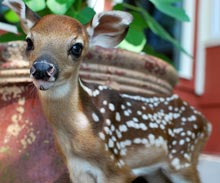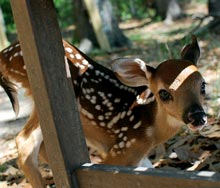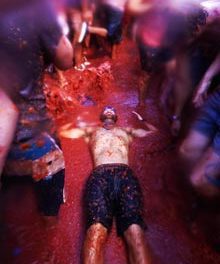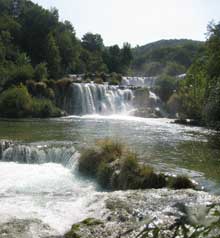 A Mother’s Day Meditation
A Mother’s Day Meditation
It’s May and an adorable White-tailed fawn is curled up by the house garden or alone by the side of the road. With one look—its big black eyes and long lashes, wobbling on its unsure newborn legs, and fur speckled with white dots—we can feel our hearts melting just a little bit inside. Naturally, we want to mother the apparently helpless creature by taking it home to care for it, because we’ve assumed the little guy is Bambied (orphaned or abandoned by the mother doe). In actuality, “99 times out of 100 that’s simply not the case,” says Charles Ruth, wildlife biologist and Deer Project Supervisor for the S.C. Department of Natural Resources (DNR).
by the house garden or alone by the side of the road. With one look—its big black eyes and long lashes, wobbling on its unsure newborn legs, and fur speckled with white dots—we can feel our hearts melting just a little bit inside. Naturally, we want to mother the apparently helpless creature by taking it home to care for it, because we’ve assumed the little guy is Bambied (orphaned or abandoned by the mother doe). In actuality, “99 times out of 100 that’s simply not the case,” says Charles Ruth, wildlife biologist and Deer Project Supervisor for the S.C. Department of Natural Resources (DNR).
Coming home from a run one afternoon I hear the cry of a fawn in the garden behind our house. I’ve never seen a fawn before, much less anything so precious. I sit down in the garden hoping not to scare her off, and instead she comes right up into my lap and begins licking my neck. I later learn it’s not unusual for fawns to follow a human “particularly when they’re only days old,” Chris says. “Their instinct is to follow something big like its mother.” The fawn wasn’t giving me little deer kisses either; she was licking the sweaty salt off my neck. Fawn, doe and buck alike have a propensity for salt around the springtime when their bodies have a nutritional strain, be it they’re growing, lactating or actively growing antlers.
Well, where is Bambi’s mother? As the fawn crashes on top of our mint plant for a nap, I – with my all too human logic and compassion – wonder how a doe can abandon her defenseless fawn. “This is a very popular misconception,” Chris says. When fawns are very young they’re not mobile enough to keep up with their mother while she forages. She’ll leave her fawn in a safe bedding place, coming back to visit four to five times a day to feed and groom her fawn. “It’s totally natural for it not to be with its mother,” he tells me. The doe will be back by nightfall to care for and protect her young.
Chris’s professional advice: “Just don’t mess with it.” So, as we enjoy the fawns – and flora – of  spring, let nature be. Touching a fawn won’t cause abandonment by its mother; the problem occurs when the animal is picked up and moved to a different location. If a fairly significant amount of time passes (overnight) in which a mother cannot find her fawn, she will give up and lose interest. A doe’s milk begins to dry up after 24 hours.
spring, let nature be. Touching a fawn won’t cause abandonment by its mother; the problem occurs when the animal is picked up and moved to a different location. If a fairly significant amount of time passes (overnight) in which a mother cannot find her fawn, she will give up and lose interest. A doe’s milk begins to dry up after 24 hours.
Sometimes, fawns appear left behind when crossing roads, as they may not be used to the feel of the pavement and they are slower than their mothers. If there is a dead or injured doe nearby, the fawn will need a rehabilitator; but, if there’s no doe in sight, she is mostly likely hidden from the roadside, awaiting her fawn. Simply help the fawn cross the road into a safe shady spot in the forest.
Never feed a fawn cow’s milk. White-tailed deer have complex, four-chambered stomachs, and feeding one anything other than their normal diet can have dire gastrointestinal consequences (although goat’s milk is commonly used as a substitute among rehabilitators).
Restrain large dogs from fawns; they can hurt them. Fawns are aware of their surroundings, so if one seems dazed and unresponsive, it may be cause for alarm; likewise, if it’s been in the same spot for more than 10 hours. If you find a fawn covered with bug bites, ticks or fleas, its not a good sign, because mothers will keep their fawns clean, Dixie Stevenson tells me. Dixie lives out by Mink Point near Walmart where she’s been rehabilitating wildlife for over 20 years.
“I get calls everyday, every hour,” Dixie laughs. She runs the 501©3 nonprofit Little Friends Wildlife Center from her home along with her husband Tom, whom she says will “grab a raccoon and a baby bottle in a heartbeat.” In the case of fawns, Dixie nourishes them to health, acclimates them to the outdoors and has them vaccinated before releasing them once again into the wild. “It’s an emotional thing, but that’s just part of it; you have to be able to release as well. And some of them are very ungrateful. They don’t even look back and say, ‘Bye mom.’ They just go.” Anyone concerned about bringing in an injured or orphaned animal to a rehabilitator is encouraged to call Dixie and Tom at 843-379-7075. She is always available for information and happy to train others.
 I now realize that the little Bambi crying out for its mother in our garden must’ve been in some sort of distress. The soft vocalization is used between doe and fawn when separated – usually out of panic, because it can attract predators. However, Chris assured me that if the doe was in the vicinity that it would find the fawn by its fingerprint-like scent between the hooves. Doe actually have a maternal social structure. “Physiologically the fawn is waned by about 8-10 weeks, at which point it is no longer nutritionally dependent on its mother,” Chris says. “But, in most cases it’s going to stay with that doe for years. An adult doe and her adult daughter will both have fawns, so you typically see these maternal groups of two or more doe.” The doe-fawn bond is very strong.
I now realize that the little Bambi crying out for its mother in our garden must’ve been in some sort of distress. The soft vocalization is used between doe and fawn when separated – usually out of panic, because it can attract predators. However, Chris assured me that if the doe was in the vicinity that it would find the fawn by its fingerprint-like scent between the hooves. Doe actually have a maternal social structure. “Physiologically the fawn is waned by about 8-10 weeks, at which point it is no longer nutritionally dependent on its mother,” Chris says. “But, in most cases it’s going to stay with that doe for years. An adult doe and her adult daughter will both have fawns, so you typically see these maternal groups of two or more doe.” The doe-fawn bond is very strong.
Likewise is that of mother and child. After all, what female species other than human will raise a child for the remainder of her life? Not just 18 years, but a lifetime? She’s worked multiple jobs, the night shift, to provide for her family while never missing a birthday. She’s been there for every wound, scrape, fall or sickness. She’s dressed you up like a clown for fun, snuck popcorn from home into the movie theatres and made you practice your violin. She taught you how to tie your shoes and then to drive a car. She knew exactly where all your things were when you couldn’t find them, and she knew just the right things to say when your heart was broken. Mothers may seem like they’ll never let go, but it’s only their human nature. I dare say women are the most altruistic mothers of the animal kingdom. Happy Mother’s Day.








